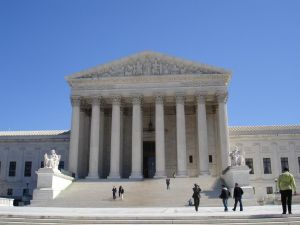 A jury recently found a veteran FBI agent guilty of assault after a three-day trial in the Montgomery County Circuit Court last week. The charges stemmed from an incident involving the custody exchange of a child, where the father was allegedly two hours late. A bystander captured the entire incident on a cellphone camera, which ultimately led to the agent being indicted for felony first degree assault, use of a firearm in a crime of violence, and misdemeanor second degree assault. Video shows that the agent, a friend of the mother of the child, was angry with the father for being late and repeatedly called him disrespectful. The agent, who was off duty and dressed in plain clothes, kept pressing the father and followed him outside of a Chevy Chase apartment building to continue to voice his displeasure. During the argument a 15 year-old boy intervened and questioned why the agent was getting involved, as he was not part of the family. At that point the agent suddenly struck the boy with and open hand to the chest that sent him tumbling down to the sidewalk on his back. As the boy picked himself up the off duty agent then attempted to place him under arrest. A brief struggled ensued, but ended quickly when the agent pulled out a handgun and threatened to shoot the boy if he didn’t comply.
A jury recently found a veteran FBI agent guilty of assault after a three-day trial in the Montgomery County Circuit Court last week. The charges stemmed from an incident involving the custody exchange of a child, where the father was allegedly two hours late. A bystander captured the entire incident on a cellphone camera, which ultimately led to the agent being indicted for felony first degree assault, use of a firearm in a crime of violence, and misdemeanor second degree assault. Video shows that the agent, a friend of the mother of the child, was angry with the father for being late and repeatedly called him disrespectful. The agent, who was off duty and dressed in plain clothes, kept pressing the father and followed him outside of a Chevy Chase apartment building to continue to voice his displeasure. During the argument a 15 year-old boy intervened and questioned why the agent was getting involved, as he was not part of the family. At that point the agent suddenly struck the boy with and open hand to the chest that sent him tumbling down to the sidewalk on his back. As the boy picked himself up the off duty agent then attempted to place him under arrest. A brief struggled ensued, but ended quickly when the agent pulled out a handgun and threatened to shoot the boy if he didn’t comply.
After receiving a copy of the video the State’s Attorney decided to present the case to a grand jury, which ended up finding probable cause to charge the agent with the three aforementioned offenses. The jury sitting in the trial court did not feel the evidence warranted convictions for the two felony offenses and acquitted the defendant on the most serious counts. But the jury agreed with the state of Maryland that the evidence supported a finding of guilt for second degree assault, as the agent had no legal authority and no defense for striking the boy. The agent’s lawyer argued unsuccessfully that the agent felt imminently threatened by the 15 year-old boy, and therefore struck him in self-defense. But the jury saw through this argument, which was hardly supported by the video.
As the verdict was announced the agent, a 20 year veteran of the FBI and current high ranking counterterrorism officer, became faint and had to be transported from the courtroom by ambulance. The case was reset until this week to deal with post-verdict matters such as setting a sentencing date and deciding whether the defendant will be allowed to keep his firearms. In Maryland a person convicted of a crime of violence such as assault is not permitted to possess a firearm. Although the defendant has been found guilty, he has not been convicted. The judge could impose a probation before judgment, which would not be considered a conviction at the January sentencing date. The Blog will track this case and may post a follow up article after the sentencing hearing, which is bound to be a tense affair. If the agent is adjudicated guilty it’s hard to see how he could remain an active duty federal law enforcement officer. But the FBI will make its own decision on that matter, and will not likely offer any explanation either way. Discipline from his employer as well as from the court seems like a given though, due to the agent’s embarrassing and violent outburst. As a law enforcement officer he was supposed to keep the peace, but instead the agent provoked a situation and ended up assaulting a private citizen, who happened to be a 15 year-old boy no less.
 Criminal Defense Lawyer Blog
Criminal Defense Lawyer Blog


 The Maryland State Police have officially charged one of their own this week, as a criminal summons has just been issued for a 28 year-old trooper. The trooper is a five-year veteran of the force who just two years ago received national recognition for his role in rendering first aid to an assault victim at an Orioles game. Now it’s the trooper himself who faces a second degree assault charge, coupled with another charge for misconduct while in office. Ironically the summons was issued to the state police headquarters in Baltimore County, and not the home address of the trooper, who is on paid leave. Police officers and other certain government employees have the right to keep their home address private, which is undoubtedly why the MSP issued the criminal summons to their Pikesville office.
The Maryland State Police have officially charged one of their own this week, as a criminal summons has just been issued for a 28 year-old trooper. The trooper is a five-year veteran of the force who just two years ago received national recognition for his role in rendering first aid to an assault victim at an Orioles game. Now it’s the trooper himself who faces a second degree assault charge, coupled with another charge for misconduct while in office. Ironically the summons was issued to the state police headquarters in Baltimore County, and not the home address of the trooper, who is on paid leave. Police officers and other certain government employees have the right to keep their home address private, which is undoubtedly why the MSP issued the criminal summons to their Pikesville office. One of the busiest and most densely populated areas in Baltimore County is quickly becoming one of the most dangerous as well. Towson is the county seat or capital of Maryland’s third largest county, and is home to over 55,000 residents. The population is on the steady incline, and new residential development projects promise to bring a dramatic population increase over the next decade. Towson is typically regarded as a low crime area, and although the thousands of college students studying at Towson University and Goucher College can cause a little trouble from time to time, most of the crime in the area is limited to minor drug and alcohol offenses. But recent figures released by the Baltimore County Police suggest that violent crime may be rearing its ugly head in the area.
One of the busiest and most densely populated areas in Baltimore County is quickly becoming one of the most dangerous as well. Towson is the county seat or capital of Maryland’s third largest county, and is home to over 55,000 residents. The population is on the steady incline, and new residential development projects promise to bring a dramatic population increase over the next decade. Towson is typically regarded as a low crime area, and although the thousands of college students studying at Towson University and Goucher College can cause a little trouble from time to time, most of the crime in the area is limited to minor drug and alcohol offenses. But recent figures released by the Baltimore County Police suggest that violent crime may be rearing its ugly head in the area. More than a year ago the Maryland Court of Appeals threw out Alonzo King’s rape conviction after ruling that police had illegally seized his DNA sample. Mr. King was arrested on an unrelated assault charge in 2009 and his DNA was collected under authority of a state law, which allowed cops to collect such samples from anyone arrested for a serious offense. This sample was fed into an FBI cold case database several months later and it matched an unidentified sample taken from the scene of a 2003 rape. Arrest and prosecution followed soon thereafter, and Mr. King suffered the same fate that most defendants do when trying to fight a case with inclulpatory DNA evidence, as he was found guilty and later sentenced to life in prison. Shortly after the Court of Appeals vacated King’s guilty plea the United States Supreme Court agreed to hear the case on a writ of certiorari. During the past year Mr. King, and to a lesser extent state law enforcement officers, Governor O’Malley, Attorney General Gansler, and anyone with direct or indirect concerns about our civil liberties have been on edge waiting to hear from the Court, and as of this week the wait is over.
More than a year ago the Maryland Court of Appeals threw out Alonzo King’s rape conviction after ruling that police had illegally seized his DNA sample. Mr. King was arrested on an unrelated assault charge in 2009 and his DNA was collected under authority of a state law, which allowed cops to collect such samples from anyone arrested for a serious offense. This sample was fed into an FBI cold case database several months later and it matched an unidentified sample taken from the scene of a 2003 rape. Arrest and prosecution followed soon thereafter, and Mr. King suffered the same fate that most defendants do when trying to fight a case with inclulpatory DNA evidence, as he was found guilty and later sentenced to life in prison. Shortly after the Court of Appeals vacated King’s guilty plea the United States Supreme Court agreed to hear the case on a writ of certiorari. During the past year Mr. King, and to a lesser extent state law enforcement officers, Governor O’Malley, Attorney General Gansler, and anyone with direct or indirect concerns about our civil liberties have been on edge waiting to hear from the Court, and as of this week the wait is over. Each year during the summer, the Maryland State Police releases its uniform crime report for the state of Maryland. The crime report uses data collected from every police jurisdiction in all 24 Maryland counties, but only factors in reported crimes in the report. The Maryland State Police defines reported crimes as actual incidents reported to police by victims, witnesses, and other sources used by law enforcement. Complaints of crime that law enforcement deem unfounded are not included in the reported crimes data. The annual uniform crime report is by no means a complete study of all crime in Maryland. In fact, the report only includes eight umbrella crimes in two separate categories, which are violent crimes and property crimes. A specific crime that does not fit into one of the umbrella crimes is not included in the report. Thus many of the most common crimes in Maryland such as DUI, drug possession, and drug sale are not included. In sum, the annual report is not a study of how many people are breaking the law in Maryland each year. Rather, the report analyzes the crimes that that have the greatest impact on citizens, and gauges how safe we really are throughout Maryland.
Each year during the summer, the Maryland State Police releases its uniform crime report for the state of Maryland. The crime report uses data collected from every police jurisdiction in all 24 Maryland counties, but only factors in reported crimes in the report. The Maryland State Police defines reported crimes as actual incidents reported to police by victims, witnesses, and other sources used by law enforcement. Complaints of crime that law enforcement deem unfounded are not included in the reported crimes data. The annual uniform crime report is by no means a complete study of all crime in Maryland. In fact, the report only includes eight umbrella crimes in two separate categories, which are violent crimes and property crimes. A specific crime that does not fit into one of the umbrella crimes is not included in the report. Thus many of the most common crimes in Maryland such as DUI, drug possession, and drug sale are not included. In sum, the annual report is not a study of how many people are breaking the law in Maryland each year. Rather, the report analyzes the crimes that that have the greatest impact on citizens, and gauges how safe we really are throughout Maryland. The United States Supreme Court will temporarily allow Maryland law enforcement agencies to resume their post arrest DNA testing policies according to an order signed by chief justice John Roberts. The DNA testing policies allow all Maryland law enforcement agencies to take DNA samples of suspects arrested for violent crimes such as robbery, assault, rape, and homicide. The law also allows police to take DNA from a suspect that is arrested for burglary. Although burglary is not a violent crime, it is a crime that is often only solved when forensic evidence such as DNA or latent fingerprints is recovered from the crime scene. Maryland police agencies are not allowed to take DNA samples upon arrest of suspects that are incarcerated for common non-violent crimes such as DUI, possession of marijuana, and drug distribution.
The United States Supreme Court will temporarily allow Maryland law enforcement agencies to resume their post arrest DNA testing policies according to an order signed by chief justice John Roberts. The DNA testing policies allow all Maryland law enforcement agencies to take DNA samples of suspects arrested for violent crimes such as robbery, assault, rape, and homicide. The law also allows police to take DNA from a suspect that is arrested for burglary. Although burglary is not a violent crime, it is a crime that is often only solved when forensic evidence such as DNA or latent fingerprints is recovered from the crime scene. Maryland police agencies are not allowed to take DNA samples upon arrest of suspects that are incarcerated for common non-violent crimes such as DUI, possession of marijuana, and drug distribution. A Baltimore City police officer was recently charged with assault after being involved in an altercation in Harford County, Maryland. The exact facts surrounding the altercation are in dispute, but the Baltimore police officer certainly has an interesting explanation for how he became involved in the assault. The criminal charging document alleges that the 10 year Baltimore police veteran, who was off duty at the time, approached a parked vehicle with two occupants seated inside. The police officer was apparently yelling at the occupants to stop dealing drugs, and approached the car in a threatening manner despite not seeing any actual drug transaction taking place.
A Baltimore City police officer was recently charged with assault after being involved in an altercation in Harford County, Maryland. The exact facts surrounding the altercation are in dispute, but the Baltimore police officer certainly has an interesting explanation for how he became involved in the assault. The criminal charging document alleges that the 10 year Baltimore police veteran, who was off duty at the time, approached a parked vehicle with two occupants seated inside. The police officer was apparently yelling at the occupants to stop dealing drugs, and approached the car in a threatening manner despite not seeing any actual drug transaction taking place.  Road rage and aggressive driving incidents in Maryland have become common in the last decade, and law makers have been forced to address the issue, but rarely does a road range incident make news headlines. Unfortunately a recent dangerous road rage incident appeared in the news just last weekend. The Maryland state police has reported that a road rage incident on interstate 295 in Baltimore has resulted in a pair of arrests and multiple serious injuries. Police arrested one Maryland man who was the driver of the main vehicle involved in the road rage incident for DUI, assault, and destruction of property. The passenger, another Maryland man, was also arrested and charged with assault and malicious destruction of property.
Road rage and aggressive driving incidents in Maryland have become common in the last decade, and law makers have been forced to address the issue, but rarely does a road range incident make news headlines. Unfortunately a recent dangerous road rage incident appeared in the news just last weekend. The Maryland state police has reported that a road rage incident on interstate 295 in Baltimore has resulted in a pair of arrests and multiple serious injuries. Police arrested one Maryland man who was the driver of the main vehicle involved in the road rage incident for DUI, assault, and destruction of property. The passenger, another Maryland man, was also arrested and charged with assault and malicious destruction of property. On Sunday night in Washington D.C., Nationals 19 year old baseball phenom Bryce Harper came up to bat in the bottom of the first inning. Veteran Phllies pitcher, Cole Hamels then proceeded to throw his first pitch directly at the lower back of Harper. Harper bent over in obvious pain for a few seconds, trotted off to first base, and then scored the first run of the game a few pitches later. After the game, the veteran pitcher admitted that he purposely threw the pitch in Harper’s direction, and fully intended to hit him. Hamels stated that throwing at Harper was his way of welcoming the rookie sensation to the major leagues. The commissioner of baseball however was not impressed with Hamels’ actions nor his honesty, and suspended the pitcher for 5 games.
On Sunday night in Washington D.C., Nationals 19 year old baseball phenom Bryce Harper came up to bat in the bottom of the first inning. Veteran Phllies pitcher, Cole Hamels then proceeded to throw his first pitch directly at the lower back of Harper. Harper bent over in obvious pain for a few seconds, trotted off to first base, and then scored the first run of the game a few pitches later. After the game, the veteran pitcher admitted that he purposely threw the pitch in Harper’s direction, and fully intended to hit him. Hamels stated that throwing at Harper was his way of welcoming the rookie sensation to the major leagues. The commissioner of baseball however was not impressed with Hamels’ actions nor his honesty, and suspended the pitcher for 5 games.